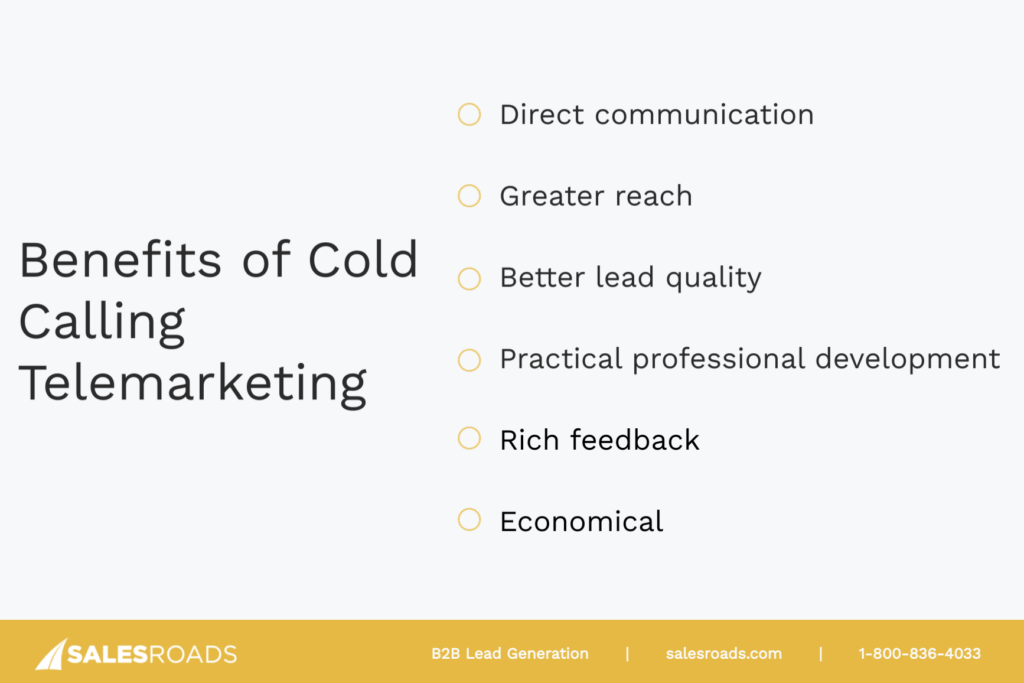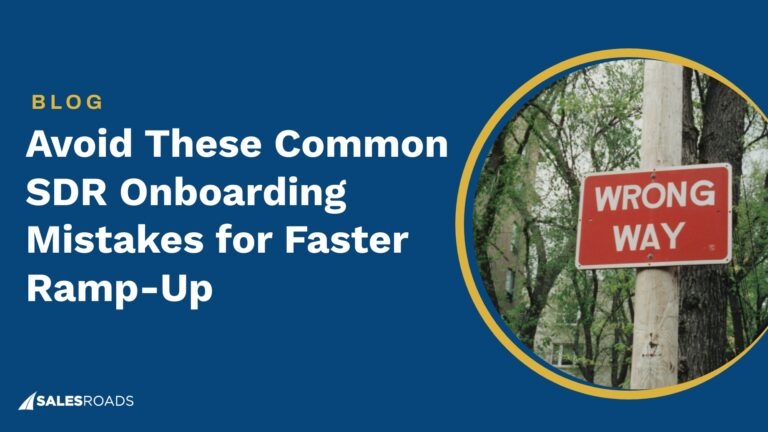Business-to-business (B2B) cold calling entails sales development representatives (SDRs) engaging with decision-makers to stimulate interest in their organization and its offerings. This interaction is ‘cold’ because the communication is unsolicited and the receiver is not expecting the call.
Is B2B Cold Calling Effective?
Research shows the phone remains a fruitful method for reaching prospects. Utilizing techniques like appointment setting, cold calling continues to be a viable strategy for generating quality business prospects, personalizing campaigns to nurture potential clients, and keeping the pipeline flowing with leads.
Tracking metrics and key performance indicators (KPIs) like contact rate, conversion rate, average call length, cost per lead, and revenue per successful call is vital for enhancing cold calling efficacy. They provide valuable insights that drive strategic decision-making and continuous refinement in cold calling campaigns.
These metrics help businesses identify the strengths and weaknesses in their strategies to guide improvement and training needs. They also optimize resource allocation by revealing the return on investment (ROI) of each cold calling campaign. Monitoring and evaluating these KPIs also helps hone audience segmentation and personalization, leading to more successful cold calls.
Advantages of Cold Calling
Businesses can enjoy impressive results from cold calling when they focus on forging personal connections with prospects to convert them into dedicated customers.

Direct communication
Cold calls enable sales development reps (SDRs) to engage prospects, gain firsthand knowledge of their business needs, and learn what’s most important to them.
Greater reach
With cold calls, businesses can connect with a large number of potential clients even in a limited time frame, which expands brand visibility and increases the likelihood of generating leads and securing deals.
Better lead quality
Cold calls help companies qualify their leads so they produce a well-honed list of strong potential customers.
Practical professional development
Sales leaders can simulate cold calling scenarios to provide on-the-job training for SDRs. This helps salespeople improve core skills like communication, prospecting, and active listening.
Rich feedback
Interactions with prospects gather valuable feedback on products and services and can uncover areas in need of immediate adjustment.
Economical
Cold calling is a cost-effective approach to boost sales, as it doesn’t require massive manpower to implement, and its remote nature circumvents overhead and running costs.
Essential Cold Calling Skills for SDRs
A successful cold call greatly hinges on the skills the SDR possesses. A combination of both soft and hard skills is essential to set reps apart when making cold calls.
Soft skills include relatability, critical thinking, resilience, and positivity. They pertain to a sales rep’s mindset and personal growth and are crucial for maintaining motivation, even when confronted with various challenges.
SDRs must also foster certain hard skills to excel in cold calling, namely, research, prospecting, value delivery, product knowledge, note-taking, and goal-setting, among others. Companies can develop these abilities in their employees through managerial feedback and coaching, sales training courses, and leveraging professional networks.
Preparation for a Cold Call
Making a cold call without adequate preparation is a recipe for failure. Here are some key steps to prepare for a cold call effectively:
Conduct thorough research
Arm yourself with all relevant information about the prospect. This equips you to convey your value proposition in a distinct and persuasive manner.
Understand the call’s purpose
The objective of a call will vary based on your company’s immediate needs. Common goals are to set an appointment, qualify prospects, generate leads, or disseminate product information. Align your preparation with the specific intent of each call to bolster your chances of success.
Use a script
A script serves as a helpful guide for the conversation by providing key details to draw on during the call. However, avoid reciting it word for word, and don’t be afraid to deviate from it when the conversation flows naturally.
Create a cheat sheet
This should contain the benefits of your products and services and highlight their major selling points. A cheat sheet keeps your offerings’ features and advantages at the forefront of your mind when speaking with the prospect.
Roleplay
Practice conversations and challenging scenarios with your managers and colleagues ahead of the call. This cultivates familiarity with your approach and fosters confidence prior to the actual conversation.
Overcoming Cold Call Reluctance
Salespeople may feel apprehensive about making cold calls due to the potential objections and rejections inherent in the practice. The best way to overcome this fear of cold calling is to tackle it head-on using these highly recommended tips:
Don’t take rejections personally
Prospects may reject your proposal simply because they don’t need your product or service at the moment. Their response isn’t representative of how they feel about you. Rejections also draw you closer to a positive outcome: Research shows 60% of leads say no four times before agreeing to a yes. 1
Prepare thoroughly
Along with boosting your chances of success, preparing adequately is an antidote to the fear of cold calling, as a bulk of it stems from a lack of readiness to engage the prospect.
Trust in your offering
You should believe your product or service is genuinely beneficial to the prospect and that you’re in a position to increase their revenue — otherwise, picking up the phone is a waste of your time and theirs.
Take a breather
Pressuring yourself to succeed can do more harm than good, especially after facing repeated rejections. Take breaks to relax, prioritize self-care, and return to your outreach when you feel refreshed.
Navigating Cold Call Gatekeepers
In B2B sales, gatekeepers take the form of receptionists, executive assistants, and other similar roles who manage access to decision-makers. When conducting a cold call campaign, you’re almost certain to encounter these individuals, so learning to handle gatekeepers effectively is crucial to the success of your outreach.
A fundamental strategy is to transform gatekeepers into allies. Accomplishing this requires treating them with respect and honesty, as well as equipping yourself with thorough research to prove you’re worthy of the decision-maker’s time.
Here are a few strategies for dealing with gatekeepers during cold calls:
- Leverage referrals – Mention a mutual connection to establish credibility for your campaign.
- Utilize the top-down or bottom-up approach – The top-down strategy involves reaching out to someone higher up in the organization to have them refer you to the decision-maker. Conversely, the bottom-up tactic starts with contacting someone lower in the hierarchy for an upward referral.
- Forge a connection – Engage the gatekeeper through common interests to build rapport and foster a personal connection.
- Make a social media introduction – Introduce yourself on social media before making the call to familiarize the lead with your business and product.
- Call outside of business hours – Gatekeepers often work within traditional office hours. Attempting to reach the decision-maker outside this time frame can easily bypass them.
- Convey urgency – Incorporating time-sensitive benefits and indicating that your message requires prompt attention can expedite access to the decision-maker.
Cold Call Structure
Sales reps are better prepared for cold calls when they have a clear understanding of the events that take place during the conversation. This knowledge is also vital to build cold call scripts that help SDRs maintain focus, address key points, and personalize interactions with prospects.
Opening statements
Cold call openers provide SDRs the opportunity to introduce themselves and their company and share the purpose of the outreach. These lines can significantly improve the success rates of cold calls, so sales reps must learn to craft compelling openers to achieve the best results.
An attention-grabbing opener has the following components:
- A greeting
- A brief introduction of the SDR and the company they represent
- Acknowledgment of the prospect’s time
- A request for permission to continue with the call
- The value proposition
Effective cold call opening lines are direct, confident, natural, and aim to pique the prospect’s interest.
Engagement/Qualification questions
Cold calling questions help pinpoint a prospect’s needs and determine if they’re a good fit for your business. These queries stimulate enlightening dialogue and are key to establishing rapport. Salespeople need to learn how to navigate cold calls with appropriate questions at different stages of the conversation.
Objection management
Cold calls are riddled with objections, as prospects may have reservations about your value proposition. Often, these are merely resistive statements leads use to evade phone conversations. Ineffective objection management can lose potential clients and thin your sales pipeline.
Various strategies are available for handling cold call objections to improve their success rate and boost campaign results. Two proven tactics are the 3 F’s method and asking follow-up questions.
The 3 F’s method (Feel, Felt, Found) involves acknowledging the prospect’s concern (Feel), sharing relatable experiences from past clients (Felt), and then presenting a positive outcome from those clients (Found).
With follow-up questions, you recognize the prospect’s objection, label it appropriately, and ask a related question to gather more information about and then address the concern.
To learn other strategies, plus common objections and their resolutions, refer to our cold call objection guide.
Closing statement
The closing statement determines the direction of future interactions with the prospect. It entails reiterating your value proposition and expressing a call to action.
Cold Call Voicemails
Eight in ten cold calls end in a voicemail, so leverage it as an initial follow-up channel. Leaving a voicemail increases the chances of a successful outreach by establishing an additional point of contact and potentially securing a callback.
Effective voicemails inspire action. They’re concise, meticulously prepared, delivered in a relaxed tone, and convey urgency with clear contact details. Salespeople should learn the components of effective cold call voicemails and craft scripts for various sales scenarios to make the most of their rich potential.
Cold Calling Services
Businesses often outsource B2B cold calling to service providers with seasoned SDRs who have a history of successfully connecting with prospects via cold outreach. Your business might consider a cold calling partner if it struggles to generate sufficient leads to fill the sales pipeline with this tactic.
Factors to consider before choosing a cold calling partner
Industry expertise
Does the company possess the necessary experience and track record to handle your cold calling process? Learn how to vet a potential partner’s industry experience in this video:
Pricing
Does their price model align with your expectations for the service? And can your business afford it for the duration of the campaign and beyond?
Fit-to-purpose programs
Can the company create custom approaches for your business’s outreach efforts, or do they depend on generic, cookie-cutter solutions? SalesRoads CEO David Kreiger shares tips on verifying cold calling customization in this video:
Data and reporting
How do they gather data for campaigns? Do they offer progress reports and ongoing statistics as each unfolds? This video explains the significance of data in cold calling:
Other services
Do they provide other sales outsourcing services such as lead generation, list-building appointment setting, or account-based marketing to produce optimal results?
Cold Call Lists
Cold call lists contain lead information for SDRs to conduct highly comprehensive outreach. When companies outsource cold calling, they may not need to provide a list, as these services often include a list-building option.
Alternatively, companies can either buy lists from data brokers or manually build one from scratch. While the former is more cost-effective and less time-consuming, it may have potential consequences that could lower outreach conversion rates.
Businesses can construct their own list by identifying their ideal customer profile (ICP) and prospecting to find those potential clients. They can also create content, such as eBooks, blogs, white papers, and webinars, to attract relevant leads and collect their information via contact forms. Given that B2B contact information can quickly become outdated, it’s essential to update your organization’s cold calling list regularly.
Bottom Line
As the business landscape evolves with emerging technologies, B2B cold calling retains its relevance and potency and is poised to remain an integral part of sales strategies for the foreseeable future. It offers businesses an economical and direct method for establishing personal connections, which are vital for converting prospects into dedicated customers.
Despite its challenges, you can significantly bolster your cold calling’s effectiveness through strategic preparation, mastering key skills, tactful gatekeeper management, and establishing structured call processes. Cold calling is a rich opportunity to improve your sales tactics, strengthen your ability to generate quality leads, and drive organizational growth.











